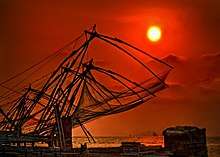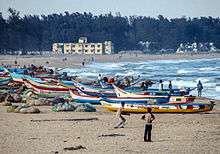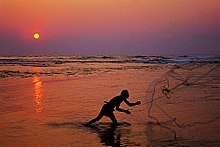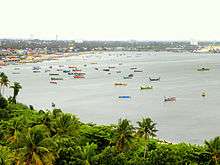Fishing in India

Fishing in India is a major industry in its coastal states, employing over 14 million people. In 2016-17, the country exported 11,34,948 metric tonnes of seafood worth US$ 5.78 billion (₹37,870.90 crore), frozen shrimp being the top item of export.[1] According to the Food and Agriculture Organization (FAO) of the United Nations, fish production has increased more than tenfold since 1947 and doubled between 1990 and 2010.[2]
India has 8,129 kilometres (5,051 mi) of marine coastline, 3,827 fishing villages and 1,914 traditional fish landing centers. India's fresh water resources consist of 195,210 kilometres (121,300 mi) of rivers and canals, 2.9 million hectares of minor and major reservoirs, 2.4 million hectares of ponds and lakes, and about 0.8 million hectares of flood plain wetlands and water bodies.[3] As of 2010, the marine and freshwater resources offered a combined sustainable catch fishing potential of over 4 million metric tonnes of fish. In addition, India's water and natural resources offer a tenfold growth potential in aquaculture (farm fishing) from 2010 harvest levels of 3.9 million metric tonnes of fish, if India were to adopt fishing knowledge, regulatory reforms and sustainability policies.[4]
History
%2C_f.204v_-_BL_Add._27255.jpg)

Historical texts like Kautilya's Arthashastra (321–300 B.C.) and King Someswara's Manasollasa (1127 A.D.) refer to fish culture.[5] For centuries, India has had a traditional practice of fish culture in small ponds. Significant advances in productivity were made in the early nineteenth century with the controlled breeding of carp in tanks where river conditions are simulated. Brackishwater farming was done on an old system where man-made impediments in coastal wetlands and salt resistant deep water paddy fields.[5]
Management
Economic benefits

Fishing in India contributed over 1 percent of India's annual gross domestic product in 2008. Fishing in India employs about 14.5 million people.[3] To harvest the economic benefits from fishing, India has adopted exclusive economic zone, stretching 200 nautical miles (370 km) into the Indian Ocean, encompasses more than 2 million square kilometers. In addition to this marine zone, India has about 14,000 km² of brackish water available for aquaculture, about 16,000 km² of freshwater lakes, ponds, and swamps; and nearly 64,000 kilometers of rivers and streams. In 1990, there were 1.7 million full-time fishermen, 1.3 million part-time fishermen, and 2.3 million occasional fishermen, many of whom worked as saltmakers, ferrymen, or seamen, or operated boats for hire.[6] In the early 1990s, the fishing fleet consisted of 180,000 traditional craft powered by sails or oars, 26,000 motorized traditional craft, and some 34,000 mechanized boats.[7]
Fish production rose from 800,000 tons in FY 1950 to 4.1 million tons in the early 1990s. From 1990 through 2010, Indian fish industry accelerated, reaching a total marine and freshwater fish production to about 8 million metric tons. In 2006, Indian central government initiated a dedicated organization focused on fisheries, under its Ministry of Agriculture. Special efforts have been made to promote extensive and intensive inland fish farming, modernize coastal fisheries, and encourage deep-sea fishing through joint ventures. These efforts led to a more than fourfold increase in coastal fish production from 520,000 tons in FY 1950 to 3.35 million tons in FY 2013. The increase in inland fish production was even more dramatic, increasing almost eightfold from 218,000 tons in FY 1950 to 6.10 million tons in FY 2013. The value of fish and processed fish exports increased from less than 1 percent of the total value of exports in FY 1960 to 3.6 percent in FY 1993. Between 1990 and 2007, fish production in India has grown at a higher rate than food grains, milk, eggs, and other food items.[8] Indian inland waters (rivers, reservoirs, wetlands, lakes and ponds) contribute 62–65% of the total fisheries production.[9]
Law and regulations
According to Indian constitution, the power of enacting laws is split between India's central government and the Indian states. The state legislatures of India have the power to make laws and regulations with respect to a number of subject-matters, including water (i.e., water supplies, irrigation and canals, drainage and embankments, water storage and water power), land (i.e., rights in or over land, land tenure, transfer, and alienation of agricultural land), fisheries, as well as the preservation, protection and improvement of stock and the prevention of animal disease. National laws include the British-era [Indian Fisheries Act, 1897, which penalizes the killing of fish by poisoning water and by using explosives; the Environment Protection Act, 1986, being an umbrella act containing provisions for all environment related issues affecting fisheries and aquaculture industry in India, the Water (Prevention and Control of Pollution) Act, 1974 and the Wildlife Protection Act, 1972. The banning of trawling by chartered foreign vessels and the speedy motorization of traditional fishing craft in the 1980s led to a quantum jump in marine fish production in the late 1980s. The export of marine products rose from 97,179 tons (Rs531 billion) in FY 1987 to 210,800 tons (Rs17.4 trillion) in FY 1992.
Research and training
Fisheries research and training institutions are supported by central and state governments. The principal fisheries research institutions which operate under the Indian Council of Agricultural Research are the Fishery Survey of India, Central Marine Fisheries Research Institute at Kochi, the Central Institute of Fisheries Education at Mumbai, the Central Inland Fisheries Institute at Barrackpore in West Bengal, Central Fisheries Corporation at Kolkata, the Central Institute of Coastal Engineering for Fisheries at Bangalore and the Central Institute of Fisheries Technology at Kochi in Kerala. Fishery training is provided by the Central Institute for Fishery Education in Mumbai, which has ancillary institutions at Barrackpore in Uttar Pradesh and Hyderabad in Telangana. The Government of India established the National Fisheries Development Board in 2006 with its headquarters in Hyderabad.[10]
The Central Institute of Fisheries Nautical and Engineering Training with facilities in Chennai, Kochi and Vishakapatnam trains operators of deep-sea fishing vessels and technicians for shore establishments. Fisheries Institute of Technology and Training (FITT) was established in Chennai in collaboration Tata Group to improve the socioeconomic condition of fishermen.[11] The Integrated Fisheries Project was established to research on processing, popularizing and marketing of unusual fish. At present there are 19 Fisheries colleges run by state Governments.
Issues
Despite rapid growth in total fish production, a fish farmers’ average annual production in India is only 2 tonnes per person, compared to 172 tonnes in Norway, 72 tonnes in Chile, and 6 tonnes per fisherman in China.[12] Higher productivity, knowledge transfer for sustainable fishing, continued growth in fish production with increase in fish exports have the potential for increasing the living standards of Indian fishermen. Fish harvest distribution was difficult within India because of poor rural road infrastructure, lack of cold storage and absence of organized retail in most parts of the country.
Indian fishermen get captured by the navies of Sri Lanka and Pakistan. Skirmishes with Sri Lankan navy often results in casualties and damage of boats.[13]
Among all the major factors impeding sustainability of fisheries, factor of climate change is the recent addition. Climate change trends along major river basins of India have revealed a warming trend (0.2–0.5 °C), declining rainfall (257–580 mm) and shifting seasonality of rainfall occurrence. Rising sea levels (1.06–1.75 mm/year), receding Himalayan glaciers and frequent occurrence of extreme weather events are also a matter as per IPCC AR5. The impact of climate change on Indian fisheries include changes in range distribution, breeding and spawning behavior, growth rates, thermal tolerance, stress physiology, invasion of exotics, impacts on aquatic primary productivity (eutrophication), habitat quality deterioration through sedimentation, water stress, aquatic weed proliferation, and saltwater intrusion. The impact of climate change on inland fish production have been mixed in nature ranging from being detrimental to beneficial in various cases. [14]
Aquaculture
Carp
Carp farming in the country started between 1970 and 1980 due to the demonstrated high production levels of 8 to 10 tonnes/hectare/year in an incubation center. Late 1980s saw the dawn of aquaculture in India and transformed fish culture into a more modern enterprise. With the economic liberalization of the early 1990s, fishing industry got a major investment boost.[4]
India's breeding and culture technologies include primarily different species of carp, including the important Indian major carp species (notably catla, mrigal and rohu); other species such as catfish, murrels and prawns are recent additions. The culture systems adopted in the country vary greatly depending on the input available in any particular region as well as on the investment capabilities of the farmer. While extensive aquaculture is carried out in comparatively large water bodies with stocking of the fish seed as the only input beyond utilising natural productivity, elements of fertilisation and feeding have been introduced into semi-intensive culture. The different culture systems in Indian practice include:[5]
- Intensive pond culture with supplementary feeding and aeration (10–15 tonnes/ha/yr)
- Composite carp culture (4–6 tonnes/ha/yr)
- Weed-based carp polyculture (3–4 tonnes/ha/yr)
- Integrated fish farming with poultry, pigs, ducks, horticulture, etc. (3–5 tonnes/ha/yr)
- Pen culture (3–5 tonnes/ha/yr)
- Cage culture (10–15 kg/m²/yr)
- Running-water fish culture (20–50 kg/m²/yr)
Prawn or shrimp
Freshwater prawn farming in India has grown rapidly since 2000 with Andhra Pradesh contributing to approximately 60 percent of the total water area dedicated to prawn farming, followed by West Bengal.[5] In fiscal 2016, India became the biggest exporter of shrimps by overtaking Vietnam. Frozen shrimp is the top item of export among seafood, accounting for 38.28 per cent in quantity and 64.50 per cent of the total earnings in dollar terms in 2016-17. The overall export of shrimp during 2016-17 was pegged at 4,34,484 MT, worth US$ 3.726 billion. USA was the largest import market for frozen shrimp (1,65,827 MT), followed by the European Union (EU) (77,178 MT), South East Asia (1,05,763 MT), Japan (31,284 MT), Middle East (19,554 MT), China (7,818 MT) and other countries (27,063 MT). Shrimp exports from India are expected to nearly double to US$ 7 billion by 2022, driven by strong demand, high quality, improved product mix, and an increase in aquaculture area in Andhra Pradesh, Gujarat, Odisha and West Bengal.[1][15]
The giant tiger prawn (Penaeus monodon) is the dominant species chosen for aquaculture, followed by the Indian white prawn (Fenneropenaeus indicus) and Pacific white shrimp (Litopenaeus vannamei). In 2015-16, West Bengal (61,998 MT) was the largest producer of tiger shrimp for export, followed by Odisha (9,191 MT). Andhra Pradesh (2,95,332 MT) was the largest producer of Pacific white shrimp.[16]
Freshwater aquaculture
Freshwater aquaculture accounts for nearly 55% of the total fish production in India.[17] Aquaculture resources in India include 2.36 million hectares of ponds and tanks, 1.07 million hectares of beels, jheels and derelict waters plus in addition 0.12 million kilometers of canals, 3.15 million hectares of reservoirs and 0.72 million hectares of upland lakes that could be utilised for aquaculture purposes. Ponds and tanks are the prime resources for freshwater aquaculture in India. However, less than 10 percent of India's natural potential is used for aquaculture currently. For bringing more areas under scientific fisheries and aquaculture, the Indian government and premier fisheries research institutes are trying hard to sensitize the fish farmers and entrepreneurs regarding the package of practices and prospects of the highly promising ‘culture-based fisheries technology (CBF)’ in inland waters. Utilization of untapped inland waters through CBF is one of the foremost strategies for achieving blue revolution. CBF is generally practiced in inland waters having areas between 100 and 1000 ha (lakes, wetlands and small reservoirs) and cautiously in 1000–5000 ha (medium-sized reservoirs) [9]
Brackishwater aquaculture
The FAO of the United Nations estimates that about 1.2 million hectares of potential brackishwater area available in India is suitable for farming, in addition to this, around 8.5 million hectares of salt affected areas are also available, of which about 2.6 million hectares could be exclusively utilised for aquaculture due to the unsuitability of these resources for other agriculture based activities. However, just like India's fresh water resources, the total brackishwater area under cultivation is only just over 13 percent of the potential water area available. Carp hatcheries in both the public and private sectors have contributed towards the increase in seed production from 6321 million fry in 1985–1986 to over 18500 million fry in 2007. There are 35 freshwater prawn hatcheries in the coastal states producing over 200 million seed per annum. Furthermore, the 237 shrimp hatcheries with a production capacity of approximately 11.425 billion post larvae per year are meeting the seed requirement of the brackish water shrimp farming sector.[5]
Distribution

.jpg)
There are five main fishing harbors at Mangalore (Karnataka), Kochi (Kerala), Chennai (Tamil Nadu), Vishakhapatnam (Andhra Pradesh) and Raichak in Kolkata (West Bengal).[18] 23 minor fishing harbours and 95 fish-landing centres are designated to provide landing and berthing facilities to fishing craft. The table below presents the top ten fish harvesting states in India, for the 2007-2008 agriculture year.
| Rank[19] | State | Total production (metric tonnes) |
|---|---|---|
| 1 | West Bengal | 1,447,260 |
| 2 | Andhra Pradesh | 1,010,830 |
| 3 | Gujarat | 721,910 |
| 4 | Kerala | 667,330 |
| 5 | Tamil Nadu | 559,360 |
| 6 | Maharashtra | 556,450 |
| 7 | Uttar Pradesh | 325,950 |
| 8 | Bihar | 319,100 |
| 9 | Karnataka | 297,690 |
| 10 | Jharkhand | 210,234 |
In 2008, India was the third largest producer of marine and freshwater capture fisheries, and the second largest aquaculture farmed fish producer in the world.[12]
References
| Wikimedia Commons has media related to Fishing in India. |
Further reading
- "Library of Congress Country Studies". U.S. Library of Congress (released in public domain). Retrieved 2007-10-06.
Citations
- 1 2 "India's Seafood Export at all-time High in 2016-17 :MPEDA". Press Information Bureau, Government of India, Ministry of Commerce & Industry. 7 June 2017. Retrieved 25 July 2018.
- ↑ "Fishery and Aquaculture Country Profiles: India". Food and Agriculture Organization of the United Nations. 2011.
- 1 2 "India - National Fishery Sector Overview". Food and Agriculture Organization of the United Nations. 2006.
- 1 2 Sasmita Panda, Gagan Kumar Panigrahi, Surendra nath Padhi, (2016). Earning Animals. Germany: Anchor Academic. p. 70.
- 1 2 3 4 5 "National Aquaculture Sector Overview: India". Food and Agriculture Organization of the United Nations. 2009.
- ↑ Area Handbook, series (1996). Area Handbook Series, American University (Washington, D.C.). Foreign Area Studies Volume 550 of DA pam. United States: American University, Foreign Area Studies. p. 416. ISBN 0-8444-0833-6.
- ↑ American University, (Washington, D.C.). Foreign Area Studies (1996). Area Handbook Series Volume 550 of DA pam. United States: American University, Foreign Area Studies. p. 416. ISBN 0-8444-0833-6.
- ↑ "Fisheries". Tamil Nadu Agricultural University, Coimbatore. 2007.
- 1 2 Roy, Koushik (2017). "Technicalities to be considered for culture fisheries development in Indian inland waters: seed and feed policy review". Environment, Development and Sustainability. doi:10.1007/s10668-017-0037-3.
- ↑ "Activities of NFDB". National Fisheries Development Board - Govt of India. 2008.
- ↑ "FITT" (PDF).
- 1 2 "The state of world fisheries and aquaculture, 2010" (PDF). FAO of the United Nations. 2010.
- ↑ "Sri Lankan navy attacks Tamil Nadu fishermen, 20 boats damaged". The Indian Express.
- ↑ "Global Climate Change and Inland Open Water Fisheries in India: Impact and Adaptations." https://doi.org/10.1007/978-3-319-90086-5_8
- ↑ "Indian shrimp exports set to nearly double to $7 billion by 2022". CRISIL. 13 December 2017. Retrieved 25 July 2018.
- ↑ Gupta, Jayanta (14 December 2017). "Big Bengal boost to India's No. 1 shrimp exporter tag". The Times of India. Retrieved 25 July 2018.
- ↑ pg.3
- ↑ Shashikala, Bhalkare (2016). Fish Economics and Fish Biotechnology. USA: Lulu Publications. p. 136.
- ↑ "Annual Report: India, 2008-2009" (PDF). Department of Animal Husbandry Dairying and Fisheries, Ministry of Agriculture, Government of India. 2009.


